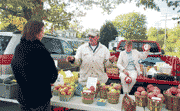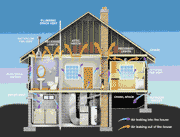|
|||||||||
15 Ways to Save the BayBay Weekly’s green choices you can make today to make a differenceby Carrie Madren, Bay Weekly staff writerGreen choices tap on our shoulders with nearly every decision we make. Many of our day-to-day tasks — from gathering food to commuting, from cooking dinner to cleaning our showers — can be greened. But making green choices for every task, product and investment in your life can make you crazy, especially when you start from zero on each one. Take buying a dryer, for example: Should you buy an Energy Star dryer? Should you instead dry your clothes on a clothesline? Should you order one manufactured as close to your home as possible in order to cut transportation distance? Most of us aren’t eco-saints. Going green can be expensive and effortful, and we feel like we fail when we can’t do it all green. So for Earth Day, Bay Weekly makes it simple to go green. Our 15 suggestions — in honor of our 15th birthday — can be achieved in a week or less. We’ve honed our list to help you get the greenest value for your efforts. Primed with small successes, you’re more likely to step up to a loftier goal — like getting geothermal heat, installing reclaimed heartwood pine floors or buying a fuel-efficient car.
1. Switch on a compact fluorescent light bulb — but don’t throw out the old incandescent one. Compact fluorescent bulbs use about 75 percent less energy than standard incandescents and last up to 10 times longer, according to the EPA. If every U.S. home replaced one light bulb with a fluorescent bulb, we’d achieve a national saving of more than $600 million in annual energy costs, and prevent greenhouse gases equivalent to the emissions of more than 800,000 cars. If you make the leap from incandescents to fluorescents, wait until the old bulb has burned out so you’ll at least get the most use out of your old bulb. Throwing out a usable product is never green. Buy them at your local hardware store.
2. Invest in rainbarrels to contain your home’s runoff. When you direct gutters into rainbarrels, rainwater can’t gather the volume and momentum to create a powerful flow that erodes sediments into waterways. As a rain barrel bonus, you’ve got free water for garden and landscaping — and for flushing toilets when the power’s out. Add extra value to your efforts down the line by replacing hardtop driveways with gravel or latticed cement. Buy them at Arlington Echo Outdoor Education Center in Millersville: (410-222-3822; www.arlingtonecho.net/rainbarrel.htm) or online from Spruce Creek Rainsaver (www.sprucecreekrainsaver.com). 3. Volunteer to pick up trash, become a stream monitor, help with shoreline restorations or plant trees. As you get your hands dirty, you invest yourself and deepen your commitment to restoring our environment. As a bonus, after some volunteer work like stream cleanups, you can see the visible difference you’ve made — as the trash piles up. Find volunteer opportunities in 8 Days a Week. 4. Compost your kitchen and yard waste — and you’ll get something valuable in return for your eco-efforts. Keeping organics out of the trash saves room in the landfill; avoiding the garbage disposal saves nutrients from flowing to waterways and food bits from going through wastewater treatment. Your reward for composting organics — like vegetable scraps, eggshells, rinds, coffee grinds, leaves and grass clippings — is free, nutrient-rich soil for your garden and landscape. Buy a compost tumbler at ComposTumbler (www.compostumbler.com). Or make your own, with instructions from the Bay Gardener (http://www.bayweekly.com/old-site/year05/issuexiii40/gardenerxiii40.html). 5. Pick up after your dog. Dog waste breaks down in rainfall, washing into waterways and groundwater. Expelled bacteria can add to dangerous bacteria counts in local waters, making them unsafe for swimming and fishing. Make a swift swoop after your pooch and your neighbors will like you better, too. Any plastic bag will do, though you can buy — and many greenspaces provide — cleverly designed bags and dispensers. Read why at www.bayweekly.com/year07/issuexv25/leadxv25_1.html
6. Tote reusable bags to the grocery store and eliminate the need for plastic or paper bags, which consume resources and energy and make waste, even if you use them more than once. If you’re a recent reusable bag convert, collect the plastic bags you’ve accumulated and return them to major grocery stores for recycling. Plastic bags from the produce section, your daily newspaper, retail stores and carryout food can also be recycled at major grocers — or used for picking up after your dog. Buy them at grocery stores and online at www.reusablebags.com.
7. Buy foods grown locally and you’ll lessen shipment across the country, hemisphere and world. That cuts carbon emitted into our air and the amount of fuel burned. Buying local also means Maryland farmers stay in business, keeping agricultural land from polluting development. Foods grown organically keep chemicals out of your system. Organic or not, locally grown food is fresher and fuller of taste and pleasure. Buy them at farmer’s market, roadside stands. Or grow them yourself. 8. Recycle half your waste. Flatten your cereal boxes and tissue-paper boxes, and re-route your toilet-paper tubes and shampoo bottles. Take recycling a step farther and become an expert on how to recycle hazardous chemicals, batteries, electronics, fluorescent lights and scrap metal. Then, reduce your garbage by buying in bulk, garnering reusable containers and shopping for items with minimal packaging. Find out what and how to recycle items in Anne Arundel County at www.aacounty.org and in Calvert County at www.co.cal.md.us/residents/waste/recycling/.
9. Spend your money in green places: Donate to eco-groups, buy wind power, support a local habitat restoration or land trust, buy from environmentally friendly companies and invest in products that use safe ingredients. Read on in this week’s review of Big Green Purse and online at www.biggreenpurse.com. 10. Buy green cleaners, instead of harsh chemical cleaners that end up down the drain and into our waterways. Chemical cleaners — which typically alert you on the label with warning or danger — also contain elements that irritate your inside and some contain suspected carcinogens. Make the switch by using up that half-empty bottle of harsh cleaner, then recycling the container and pledging to invest in green cleaners that don’t contain chlorine bleach, ammonia, phosphates or antibacterial agents. Read on about what brands to look for and how to make your own safe cleaners at http://www.newdream.org/consumer/cleaners.php. 11. Lobby your lawmakers for green laws and regulations. Environmental advocates helped pass legislation to clean up our air, use less electricity, invest in renewable energy, protect waterways and more. Lawmakers need to know that a clean environment is important to their constituents. Tell them what’s important to you through emails, letters or arranging a short appointment to chat in person. Contact your legislators through http://mlis.state.md.us/ at the state level and http://mdelect.net/ for the congressional representatives. 12. Join a green group because strength comes in numbers. At a Green Drinks gathering (www.annapolisgreen.com), chat eco-ideas over a martini, or plan an eco-community over coffee. Join a local river conservation group, like South River Federation (www.southriverfederation.net) or Spa Creek Conservancy (www.spacreek.org). Each Riverkeeper program has a group of members who volunteer, keep the riverkeeper updated and support the cause (find a listing at www.paxriverkeeper.org/main/otherriverkeepers.html). Sierra Club and Chesapeake Climate Action Network both have local chapters, too. Band together by attending gatherings and chatting.
13. Get an energy audit for your home or business to find out where you’re wasting energy, and what improvements will cut your electricity bill. You especially need an audit if you have hot or cold rooms, cold floors in winter, drafty rooms, high dust collection, moisture on windows, musty odors or peeling paint. Find an auditor from the Maryland Home Performance program (www.mdhomeperformance.org). A certified Home Performance contractor will tour your home for an energy audit, make recommendations for energy improvements, provide cost estimates and fix the problems. Often, proper insulation, sealing, windows and doors can keep heating and cooling bills down. Or do an online audit at Southern Maryland Electric Cooperative’s online energy audit to find out where your electricity is going and if your heater’s wasting energy: www.smeco.com/customer/audit/index.html.
14. Consider lawn alternatives. Trim your fuel costs and pollution emissions with a push mower that cuts grass with human-power rather than fossil fuels. Test your soil and see if what nutrients and how much your lawn needs to grow best. Or forgo lawns and plant a wildflower meadow with a meandering footpath. Buy at local hardware stores and online at www.peoplepoweredmachines.com. Get instructions and lawn testing at www.al-labs-eastern.com . 15. Eat less meat and lighten your environmental footprint by choosing grains, vegetables, legumes and other plant-based meals. Meat takes a tremendous amount of energy, food and water to get to your plate. Plus livestock cause eco-problems like grazing-related loss of cropland and animal-waste pollution in waterways. Plant-based foods are much more energy and resource efficient — and healthier. Commit to eating at least one vegetarian meal a week. Read more at: www.bayweekly.com/year08/issuexvi9/earthtalkxvi9.html. Find recipes at http://vegweb.com/. |
|||||||||
|
|||||||||
|
|
|||||||||
|
© COPYRIGHT 2008 by New Bay Enterprises, Inc. All rights reserved. |
|||||||||
 Volume 16, Issue 16 - April 17 - April 23, 2008
Volume 16, Issue 16 - April 17 - April 23, 2008






